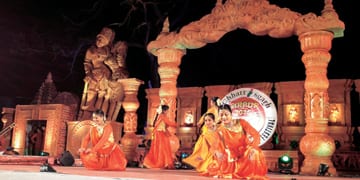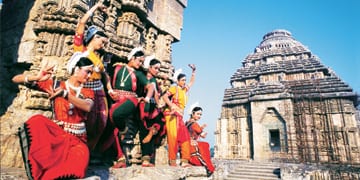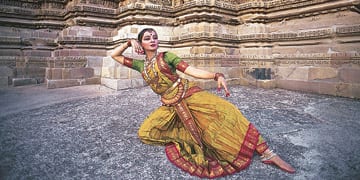Music to the ears
Despite infrastructural and connectivity challenges, Konark, Khajuraho, Elephanta, Sirpur and Modhera, host dance and music festivals that draw thousands of tourists from worldwide for a rich cultural tourism experience. State tourism boards must grow this niche tourism product to put India’s cultural legacy on the world map By Reema Lokesh
India’s exquisite classical dance and music have enthralled the West. This land has been the birth place of artists with extraordinary talents and skills who have won accolades far and wide. Though there are a few who truly appreciate the richness of India’s talent in performing arts, the good news is that the numbers of enthusiasts/ connoisseurs of art are growing. The country’s rich talent in dance and music is revered overseas and slowly but steadily there has been a change in heart towards this wealth and national possession within our country as well. The recently concluded Sirpur Dance and Music Festival was proof that both national and international tourists are travelling to these hidden heritage hubs to experience art and culture in an environment which is natural and conducted in open theatres. These tourists are also taking time out to explore the surroundings and other tourism specialties of the state with a promise to come back again to discover more. Experiential tourism is the way ahead with niche tourism gaining strength. Such quality music and dance festivals attract a refined crowd to India’s smaller towns, which need to be developed through a sustainable and responsible route. These festivals reveal a lot about what we have in store, our wealth in the field of performing arts and also the fact that these festivals have added a lot of value to the tourism potential of the regions.
Sirpur sojourn

India’s leading and well established dance and music festivals have evolved qualitatively over time both in terms of talent and performers to that of attracting quality tourism to these places of pure art and heritage. The recently concluded Sirpur Dance and Music Festival in Chhattisgarh was conducted at a place which had the seventh century Laxman Temple as its backdrop. For Santosh K Misra, MD, Chhattisgarh Tourism Board, who is the brain behind establishing the Sirpur Dance and Music Festival, the first year was a challenge. He had to build a product in a place that was still unknown on the tourism map – Sirpur. Perched on the banks of Mahanadi, Sirpur is a small town located 85 km away from the state capital, Raipur, Chhattisgarh. His commitment to establish Sirpur as a tourist destination gave rise to the now known Sirpur Dance and Music Festival. He was clear that Sirpur’ sixth century tourism wealth of Buddhism needed to be explored. “The state of Chhattisgarh has lot to offer but is seldom known,” says Misra showing images of the venue of the dance and music festival which was a dried up pond and the work they had to put in to bring it to what it is today. “Nothing comes easy, but with commitment and dedication there is a lot that can be achieved,” he adds. He feels that the place and time was opportune to introduce a dance and music festival and bring in the best talent of the country. “The first year was truly a challenge to get artists of the stature of Hariprasad Churasia to an unheard place like Sirpur,” he reveals. But Mahesh Babu, director, Banyan Tree finally shaped the festival.
The festival has showcased art forms from legendary artists namely Kathak dancer and Hindustani classical music vocalist Pandit Birju Maharaj, English percussionist Peter Robert Lockett, American saxophonist and composer George Brooks, Jazz percussionist – Phil Maturano, Indian playback singer Anuradha Paudwal, Indian musician and sitar player Shujaat Husain Khan, Indian classical musician and santoor player Rahul Sharma and Vidwan Vikku Vinayakram, the famous Ghatam player. In 2016, the festival will gain international status. He further highlights the unique aspects of the state. “Chattisgarh is a place for festivals all through the year. The Bastar Dushera festival goes on for 75 days. It is also a place perfect during the monsoons. From farm tourism to heritage tourism there is a lot to explore and experience,” states Misra, adding that there are few interesting experiences in the north of Chhattisgarh like the Jaljali village in Sarguja, along with the Tibetan experience to the medical and herbal wealth of the region.
Konark calling
The Konark Dance and Music Festival has witnessed an interesting evolution over the years. Since 1989, this festival has been organised in the state jointly by Orissa Tourism and Odissi Research Centre to promote the diverse Indian dance heritage along with the Sun Temple in Konark and Orissa as a tourist destination. The festival is a celebration of different dance forms including Bharatnatyam, Manipuri, Odissi, Kathak and Chau dance. From a regional to a national and now an international event, this festival has come a long way. Over the years, the dance academy of Guru Gangadhar Pradhan has been involved in this dance festival. Apart from witnessing the different dance forms, visitors also have the option of visiting the crafts fair which showcases various handicraft items and different cuisine options.

‘Konarka’, the place bears a name composed of two world elements : Kona meaning corner and arka meaning the sun. Over the years, there has been a bid to have dances performed in the temple precincts to recreate the ancient charm and glory of these dances. Dance festivals are aimed at hosting dances against the backdrop of ancient temple monuments. There are two events held at Konark, one in February and other in December every year. Benjamine Simon, founder, Travellinks Tours in Orissa, who has been associated with the event for long, opines, “The event has put Orissa on the global map. We get bookings from our international clientele from the UK, Germany, USA, France and Japan a year in advance. This event has also helped develop local tourism. Apart from the festival, people go about and explore the destination and especially the famous sand art creations.” He further mentions that Orissa also has close relations with Indonesia. They have artists from Bali performing at the show. The state has a diverse terrain that offers as many as 321 tourist destinations. Orissa Tourism has been working towards showcasing the cultural and religious heritage of the state and its people through numerous festivals and fairs such as the Konark Dance and Music Festival, Gotipua Dance Festival, Rajarani Music Festival, Dhauli Kalinga Mahotsav, Toshali National Crafts Mela, to name a few. Orissa is also closely linked with Buddhism with the Kalinga war region in its fold.
Elephanta experience
Celebrating the living heritage of Indian dance, art and sculpture, the Elephanta Festival has gained popularity over the years by creating a wide platform for local and national artists, dancers and musicians to showcase their talents. Started in 1989, the Elephanta Festival is one of the most prominent festivals in Mumbai celebrated to promote tourism and culture in the city. Organised by Maharashtra Tourism Development Corporation (MTDC) in association with Tata Consultancy Services (TCS), the yearly Elephanta Festival, is usually held at Elephanta Caves, a World Heritage Site and sometimes at the Gateway of India. The day activities, which spans from morning to six in the evening includes guided tours, painting competitions, to name a few. While the evening cultural programmes which consists of classical dances, plays, skits, instrumental and vocal recitals continues till 10 pm at night. Apart from displaying myriad talents from across the nation, this festival also promotes local creativity. “We are supporting the local community to have their traditional cultural programmes in the Tarapur village,” opines an MTDC official. The festivities start with a folk dance from the local fishermen (Koli).
As for arrangements, there are launches ferrying visitors at intermittent intervals to the heritage site. The highlights of the festival are the several ethnic food stalls displaying the traditional food of the region. Elephanta Caves is located at a distance of 10 km from Mumbai Harbour. The initial name of Elephanta Caves was Gharapuri which means, ‘a peaceful living place of Lord Shiva’. The name Elephanta Caves was given by the Portuguese, after a carved elephant was found on the island.
Khajuraho klassic
The Khajuraho Dance Festival is one of the most celebrated festivals of India exemplifying the classical dance traditions of the country. The Khajuraho Dance Festival organised by the Madhya Pradesh Kala Parishad is a one week long festival of classical dances held annually against the backdrop of the Khajuraho Temples in Chhatarpur district of Madhya Pradesh. During the festival, the richness of India’s tradition is highlighted through various dance forms such as Kathak, Bharatnatyam, Odissi, Kuchipudi, Manipuri and Kathakali. The festival is organised every year in the first week of February. The dances are performed in an open-air auditorium, usually in front of Chitragupta Temple and Vishwanatha Temple.

Speaking about the importance of the festival, Ashwani Lohani, MD, Madhya Pradhesh Tourism Development Corporation says, “This festival has gained international recognition and the destination is a prominent tourism attraction. It is extremely rich in heritage and culture. We are focused on improving connectivity to the region to give the Khajuraho Dance Festival greater strength by effectively connecting Khajuraho to other places within India especially Mumbai and New Delhi as they are our gateway cites.” Though the festival brings in international tourists, it has the potential to achieve much more. Khajuraho has become trapped in the mythical folklore of the region. If the myth is to be believed, Khajuraho was known as ‘Khajur-vahika’ or ‘Khajjurpura’ in the ancient times because of its golden date palms (known as ‘khajur’) that lined the gates of this city.
Modhera magic
The Sun Temple at Modhera in Mehsana district is situated on the banks of Pushpavati river. Constructed in 1026-27 AD during the reign of King Bhimdev I of Patan, the temple is dedicated to Surya or Sun deity. It is a specimen of superb artistry of Gujarat’s architects of the bygone days. Modhera’s Sun Temple is positioned in such a manner that at the equinoxes the rising sun strikes the images in the sanctuary. The outer walls of the temple are covered with sculptures in which the figures of Surya, the sun god are prominent. The Sun Temple also incorporates an amusement park, a museum, a cafeteria, picture gallery and library.
The Modhera Dance Festival organised by Gujarat Tourism, is a major festival that is observed at the Sun Temple. This dance festival is organised to promote tourism and keep the Indian traditions and culture alive. It is held in the third week of January every year. The Modhera Dance Festival which is also known as the Uttarardh Mahotsavor Modhera Utsav is one of the most famous celebrations of art, music, dance and culture in this part of the country. This festival showcases traditional dance forms of the region as well as acts as a platform bringing together the cultural ethos of other regions expressed in form of dance or nritya. Modhera, the temple of the Sun narrating the history and grandeur of its patrons, the Solankis, is an architectural marvel. This peerless temple space acts as a grandiose backdrop for the dancers. Dance troupes and performers from all regions of the nation bring varied dance forms and styles, interlaced with the essence of their origins. The Modhera festival is an ideal opportunity to experience the living heritage of Indian dance and music. Nearby destinations to explore are, Becharaji temple, Unjha, Patan, Sidhpur and Mehsana.
With inputs from Rituparna Chatterjee




